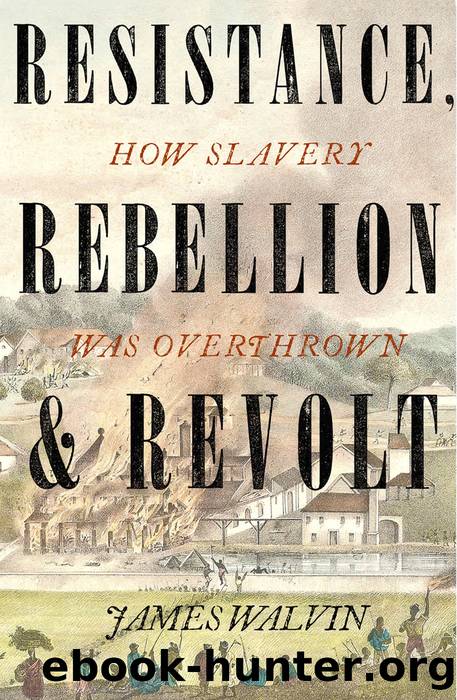Resistance, Rebellion and Revolt by James Walvin

Author:James Walvin
Language: eng
Format: epub
Publisher: Little, Brown Book Group
Published: 2020-12-03T00:00:00+00:00
8
The End of Slavery in the Spanish Empire
SPAIN HAD BEEN the first European country to introduce Africans into the Americas, and Spanish colonies clung to slavery longer and more tenaciously than all others lands apart from the former Portuguese colony of Brazil. Like all European colonial powers in the Americas, imperial Spain made great use of African slaves, although, unlike others, it did not become a major Atlantic slave trader. Instead Spain relied on other nationsâ trading and maritime expertise for its supply of Africans.
Spain conquered, or claimed, vast areas of South America and the Caribbean islands. âNew Spainâ embraced Puerto Rico, Cuba, Jamaica, Mexico and Central America, and Spanish Peru consisted of the entirety of South America with the exception of Brazil. Slavery spread unevenly across so huge a landscape. Spainâs mainland American colonies absorbed slightly more than a quarter of a million Africans. At the most southerly tip, RÃo de la Plata, only 67,000 Africans arrived as slaves. In the Caribbean, 26,700 Africans went to Puerto Rico, but by far the largest number â more than three-quarters of a m illion â were taken to Cuba, most of them during that islandâs boom years in the nineteenth century. Compared to the millions poured into Brazil, these numbers seem small, but this does not diminish the importance of slavery to Spanish colonisation in its American empire.
Unlike Portugal and Britain, Spain developed only a marginal role both on the continent of Africa and in the Atlantic slave trade. Partly as a result, it was widely thought both that slavery was peripheral to Spanish history, and that the Spanish version was also more benign than other slave systems. (This was a view sustained by twentieth-century Spanish politics.) It is now broadly accepted that this analysis was wrong and, on the contrary, African slaves were basic both to the establishment and to the development of Spanish America. Equally, Spanish slavery was no less harsh than slavery elsewhere. Older arguments that imperial law and church practices served to temper Spanish slavery have been replaced by the awareness that slavery was propelled by the dictates of plantation labour. And that involved the harsh exploitation of African slaves, especially in Spainâs sugar and coffee industries. Spainâs initial slave system in the Caribbean faded as Spain turned its attention away from the islands and towards the rich potential of Mexico, Central America and the wealth of the Andes, but it revived in the nineteenth century.
Although the numbers of Africans taken to Mexico and Central America were small compared to other regions of the Americas, the impact of slave labour was vital across the region. The background was the disaster that befell indigenous Indian populations in the wake of the European invasions. The impact of alien diseases imported by Europeans was catastrophic, with native peoples suffering massive population losses: in places, upwards of three-quarters of their pre-conquest levels. Indeed population collapse seems âto have been the rule across Spanish America in the aftermath of conquestâ.[1] From the first, Spanish settlers had needed labour, but Indian people fled, fell ill or died.
Download
This site does not store any files on its server. We only index and link to content provided by other sites. Please contact the content providers to delete copyright contents if any and email us, we'll remove relevant links or contents immediately.
Zero to IPO: Over $1 Trillion of Actionable Advice from the World's Most Successful Entrepreneurs by Frederic Kerrest(4298)
Machine Learning at Scale with H2O by Gregory Keys | David Whiting(4185)
Never by Ken Follett(3794)
Harry Potter and the Goblet Of Fire by J.K. Rowling(3775)
Ogilvy on Advertising by David Ogilvy(3511)
Shadow of Night by Deborah Harkness(3304)
The Man Who Died Twice by Richard Osman(2997)
Book of Life by Deborah Harkness(2868)
The Tipping Point by Malcolm Gladwell(2827)
Will by Will Smith(2794)
0041152001443424520 .pdf by Unknown(2784)
My Brilliant Friend by Elena Ferrante(2774)
How Proust Can Change Your Life by Alain De Botton(2743)
Purple Hibiscus by Chimamanda Ngozi Adichie(2652)
How to Pay Zero Taxes, 2018 by Jeff A. Schnepper(2602)
Hooked: A Dark, Contemporary Romance (Never After Series) by Emily McIntire(2502)
Rationality by Steven Pinker(2291)
Borders by unknow(2229)
Can't Hurt Me: Master Your Mind and Defy the Odds - Clean Edition by David Goggins(2228)
